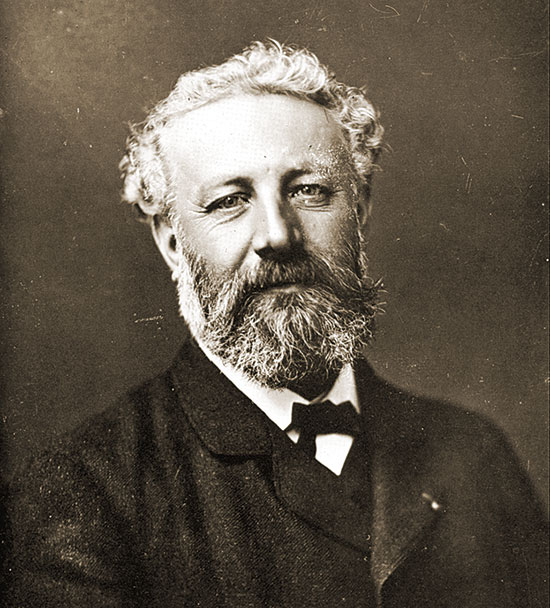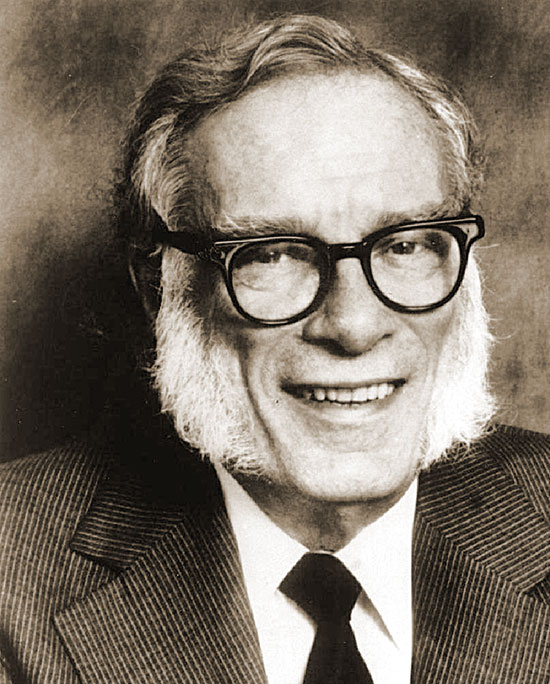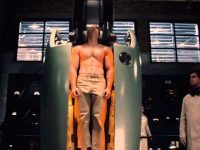Science novels
Science and technology in fiction

Most literature frequently ignores the essential role that science and modern technology play in shaping current societies and how we live in them. Around 150 years ago, Jules Verne started to become aware of the need to actively include science and technology in modern narratives. He named it «the science novel». Later, the literary genre of science fiction seemed to reach the point which Jules Verne’s science novel had pioneered. In this regard, science fiction posits itself as a suitable narrative to learn about the future, as it describes worlds which are possible due to science and technology.
Keywords: Jules Verne, science fiction, literature, science novel.
The science novel
The year 2005 witnessed the first centenary of the death of Jules Verne. This author has been almost entirely forgotten, yet for many years Verne was a reference point in literature for children and adolescents, as was the case midway through the twentieth century.
Those were different times: the market potential of stories with children and young people playing the main characters had not yet been discovered and books were not essentially written for these age groups. The Famous Five, or The Secret Seven, by Enid Blyton (1897-1968), were a weak precursor to today’s adventures of Harry Potter, Geronimo Stilton and many others. Broadly speaking, at that time, reading for children and adolescents followed three main threads: the endless adventures of Emilio Salgari (Sandokan, The Tigers of Mompracem and The Pirates of Malaysian), Louisa May Alcott’s Little Women and the innovative narratives of Jules Verne, which dealt with scientific and technical themes.
«Verne’s aim was not to teach science but, rather, he wanted to include it in man’s adventures»
Indeed, halfway through the nineteenth century, it was Jules Verne who realised that science and technology occupied a noteworthy role in people’s lives and he attempted to write and even theorise about what he himself called «the science novel». In this type of novel, science and technological activity would no longer be absent from the narrative as they had been previously. It was not simply a matter of creating narratives to be exclusively read and enjoyed by children, although that is how the stories were to be presented by Verne’s editor, Pierre-Jules Hetzel, creator of the label «Extraordinary Voyages» given to Verne’s first works (Navarro, 2005).
In Verne’s imaginary adventures the protagonists travel from one end of the earth to the other and even visit unchartered territories such as the bottom of the ocean, the depths of the Earth or the path to the Moon. It must not be forgotten that the great science of the nineteenth century was geography, with the exploration of the earth and relevant discoveries. Aside from the journey and the extraordinary adventures which took place, the narrative was also an excuse to educate readers (initially children as we have already seen) about the realities and wonders of science. Indeed, Jules Verne has gone down in history as one of the great founding fathers of a new literary genre, science fiction, which was pioneered by him in France and by the Fabian socialist Herbert G. Wells in Great Britain some decades later (Aldiss and Wingrove, 1986).
The question we must ask is: why do science and technology not appear regularly in prevalent narratives 150 years later? Verne was the pioneer, but following on from him and his «science novel», narratives incorporating science and technology have been relegated to the ghetto of genre baptised as science fiction.
Science in the work of Jules Verne
Verne was not a scientist; however, he was very well-informed about the scientific and technological developments of his period. It seems that he frequented various specialised libraries and made abundant notes and index cards which greatly helped him to become almost an expert on the topics dealt with in his novels.

Perhaps because of this, there are mistaken rumours which suggest that he himself was the inventor of the contraptions which appear in his books, despite the fact that they are simple fabrications and novelistic depictions of things that already existed at that time, and which Verne knew about thanks to his work in libraries and his contact with various friends who were scientists or explorers.
The typical example is the submarine Nautilus which Verne describes in Twenty Thousand Leagues Under the Sea (1868). Despite appearances, this was neither Verne’s prediction nor invention: the idea of subaquatic navigation was already known about and had been serious analysed in a study by William Bourne dating all the way back to 1578. In May 1801, under the financial patronage of Napoleon, Robert Fulton built a prototype submarine with a four-person capacity and, indeed, it was named Nautilus. Even the Ictíneo by Narcís Monturiol, built in 1858, was successfully tested in Barcelona’s harbour in 1859, almost ten years before the publication of Verne’s novel. Moreover, on the 17th February 1864 in the port of Charleston (South Carolina), the prototype submarine H. L. Hunley, was used by the Confederacy in a civil-war manoeuvre to torpedo a Union boat, the Housatonic. Verne did not devise the submarine, he simply used it in his novel, albeit in the service of a solitary, somewhat antisocial and slightly misogynistic hero (Barceló, 2000).
«Aside from the journey and the extraordinary adventures which took place, the narrative was also an excuse to educate readers about the realities of science»
However, it is true to say that in other cases, Verne was ahead of his time due to his imagination linked with a good knowledge of science at that time. It must also be acknowledged that many of the technological contraptions thought up by Verne have subsequently been swept away by reality as techno-scientific knowledge has developed and grown. However, the visions conveyed by Verne of the oceanic abyss, of Earth’s depths, of a possible journey to the Moon, or of possible subaquatic ships such as the Nautilus or flying vessels such as the Albatross (a predecessor of the autogyro or helicopter), do indeed have a firm and intelligent grounding in scientific knowledge of the time, one and a half centuries ago.
Verne’s objective was not to teach science but, rather, he wanted to include it in man’s adventures, almost always from a positive and favourable perspective. For example, the castaways in The Mysterious Island would not have been able to survive without the help of Cyrus Smith, and his almost encyclopaedic scientific knowledge (especially of chemistry) and spectacular practical sense. Thanks to this techno-scientific knowledge, he became the indisputable leader of the prodigious adventure.
Science in fiction
Can intelligent life exist on a neutron star? Can we reach stars which are many light years away from our solar system? Does the magnetic monopole exist? Is it possible to send a message back in time by modulating a tachyon beam? Is it possible to develop artificial intelligence with the personality of Sigmund Freud or Albert Einstein?
Because of what we now know, all of these questions have the same answer: a categorical no. However, the fact that science denies us these opportunities does not mean that we cannot speculate. This is one of the primary functions and greatest attractions of science fiction. One of science fiction’s many objectives is to speculate in an amenable way about «the human response to changes in scientific knowledge and technology» according to Isaac Asimov, a well-known propagator of science and famous science-fiction author (Asimov, 1977).

Science fiction began to gain popularity in the nineteen forties and fifties precisely because of authors, now classics, who possessed good scientific knowledge: Isaac Asimov held a doctorate in chemistry, and was a university professor; Arthur C. Clarke was one of the pioneers of astronautical research and was the first person to propose using geostationary satellites as communications hubs; Robert A. Heinlein was a naval engineer, etc. The list could be extended and include names of people who singlehandedly fulfilled the roles of scientist, propagator, and science-fiction novelist, as is the case with Asimov and Clarke, already mentioned, or also Carl Sagan, Gregory Benford, and a long list of others.
In reality, many science-fiction authors use their solid scientific knowledge as a basis for narrations full of scientific reference. This is the case with specialists such as Gregory Benford, David Brin, Robert L. Forward, Vernor Vinge, Charles Sheffield and many others who, owing to their knowledge, justify the serious speculation espoused by the strand of science fiction (typically named hard), which centres on science and technology. The accessibility of their stories and the intelligence of their speculations ensured that science fiction became the defining narrative genre of the twentieth century, and the one which has best helped us to imagine some of the possible futures which lie in wait (Nicholls, 1983).
The science fiction genre
Aside from spreading scientific knowledge or popularising science, it must be made clear that science fiction is basically a genre. Or, better phrased, it is a series of themes which find their best expression in mediums such as literature, cinema, television, comics, or different narrative arts. Above all, literary science fiction (the source of all science fiction), is art, and as such, it would seem to belong to a world which we consider different to that of science.
However, as narrative subject matter, science fiction enjoys its own characteristics which are what make it special and are well worth remembering.
«Change looms over our civilisation in an obsessive way, as it never had done with our predecessors»
On one hand, science fiction is a genre that offers risky speculations, which frankly are often deliberate and made to make us reflect about our world and social organisation or about the effects and consequences of science and technology in the societies which use them. This is the reflective side of science fiction, which has often served to define science fiction writing as a real literature of ideas. It serves the purpose of the so called «counterfactual conditional», which consists in asking: «What would happen if…?» about hypothetical ideas which are considered too unbelievable or which are too premature to occur in real, daily life.
However, on the other hand, science fiction offers almost inexhaustible possibilities to marvel and admire. New worlds and beings, new cultures and civilisations, new scientific and technological achievements, all these elements open our mind’s eye to an unknown universe to be viewed with surprise as we move deeper into new and unsuspected territories. This leads specialists to talk of an important «sense of wonder» as being one of most attractive elements of science fiction and one that most clearly defines it (an element which it should be remembered is shared with other successful current genres: the historical novel, travel novels, etc.) (Barceló, 1990).
The scientific adventure
Perhaps, the first important literary reference to science and what it represents for societies which practice and adopt it, is to be found in Mary Shelley’s 1818 work Frankenstein. Unfortunately, cinema has distorted the popular image of what was then a serious reflection about the power of science and its ultimate responsibility. Mary Shelley subtitled her novel «the modern Prometheus», in order to highlight the fact that the scientist, doctor Frankenstein, as Prometheus, takes the risk of doing what is «forbidden», precisely because he wants to offer humanity new opportunities which have thus far been denied.
Thus, science fiction historians such as the Briton Brian W. Aldiss, tend to consider Mary Shelley’s Frankenstein to be the first science fiction novel (Aldiss and Wingrove, 1986) in accordance with Isaac Asimov’s previously mentioned definition: a speculation «about the human response to changes in scientific knowledge and technology».
Logically, within the context of British society during this period at the beginning of the nineteenth century, the novelty of doctor Frankenstein’s intentions served as a warning about the dangers which certain forms of science could entail. Perhaps because of this, the cinematic version of Frankenstein made by James Whale in 1931, largely forgets the scientific section (and the tale of undertaking science) which has such a presence in Mary Shelley’s novel. Instead, the story becomes a basic reference point for horror films, and it could be argued that it makes a warning statement against science and its dangers. Unfortunately, the classic first work of literary science fiction is changed irremediably when made into a film.

Incidentally, quite recently in 1995, Kenneth Branagh was able to recover the spirit of exploration and adventure which Mary Shelley glimpsed in science, and was fortunately able to contribute this to his cinematic version of poor doctor Frankenstein’s misfortunes. Shelley wanted to open the novel with the meeting between doctor Frankenstein and Captain Robert Walton, who is trying to reach the North Pole. Branagh also retains this element. The meeting between Walton and Frankenstein helps to convey the idea that science is an adventure similar to that which motivates people such as Walton to seek out unchartered lands in search of something new. This is precisely what scientists do.
Science fiction as a method of learning about the future
At the outset of the sixties, a book was published which enjoyed considerable success amongst the public and media. It warned about the «premature onset of the future». This book was Future Shock, by the North American essayist Alvin Toffler, who pondered the rapidity of change within a culture such as our own, controlled by the effects of science and technology and subject to its exceptional transformative power.
Toffler’s central idea can be expounded in an almost intuitive and familiar way with a simple example: only 200 or 300 years ago, our predecessors were born and learnt to live in a world which, generally, remained the same until their deaths. Human lives were affected by very few changes. However, we no longer enjoy this luxury: the future collapses in on us at a frenetic rate, and a large proportion of this increased rate of change is due to the perspective of novelty offered by modern techno-science (Toffler, 1970).
«To omit science from literature is akin to forgetting essential elements of our world»
Having moved into the new millennium, the pace of change has quickened so much that we now know that the world where we have learned to live and to relate with others will not remain the same for any substantial part of our lives. Change looms over our civilisation in an obsessive manner, as it never had done with our predecessors. We are required to coexist with the future and the changes it brings.
Yet we know little of the future, other than the fact it will be different from the past and the present moment we live in. We must train ourselves to live in a future which will invariably be «different» because of science and technology.
Science fiction can help us to do this. It helps us to confront, even if only intellectually, different possible futures. It shows the changeability of the present and the numerous changes which can modify life and the social organisation of humanity. Science fiction may be a useful tool in helping us to comprehend a future we know so little about. It also permits us to imagine alternative ways of living and organising society. This is no small achievement.
Concluding remarks
Despite C. P. Snow’s warning about the two cultures (humanities and science, to be precise), the fact is that literature, the science novel, science fiction, whatever we may call it, can indeed be linked to science. Moreover, it can lead us towards a better understanding of the current world which is controlled by the effects of science and technology.
In an ever-more complex world, wherein science and technology play a determining role, it is absolutely imperative that we include science and technology and their effects in narratives which speak to us about humanity. To do otherwise, as is the case with much current literature, is to ignore essential aspects of the world we live in, aspects we would also like to reflect upon through storytelling.
References
Aldiss, B. W. and D. Wingrove, 1986. Trillion Year Spree: The History of Science Fiction. Victor Gollancz. London.
Asimov, I., 1977. Asimov on Science Fiction. New Doubleday. New York.
Barceló, M., 1990. Ciencia Ficción: guía de lectura. Ediciones B. Barcelona.
Barceló, M., 2000. Paradojas: ciencia en la ciencia ficción. Equipo Sirius. Madrid.
Navarro, J., 2005. Somnis de ciència: un viatge al centre de Jules Verne. Bromera/PUV. Alzira/Valencia.
Nicholls, P. (ed.), 1983. The Science in Science Fiction. Alfred A. Knopf. New York.
Toffler, A., 1970. El shock del futuro. Plaza y Janés. Barcelona.





